See also
- Henry (given name), an equivalent English given name
- Hurricane Henri (disambiguation)
Henri is the French form of the masculine given name Henry , also in Estonian, Finnish, German and Luxembourgish. Bearers of the given name include:

1652 (MDCLII) was a leap year starting on Monday of the Gregorian calendar and a leap year starting on Thursday of the Julian calendar, the 1652nd year of the Common Era (CE) and Anno Domini (AD) designations, the 652nd year of the 2nd millennium, the 52nd year of the 17th century, and the 3rd year of the 1650s decade. As of the start of 1652, the Gregorian calendar was 10 days ahead of the Julian calendar, which remained in localized use until 1923.
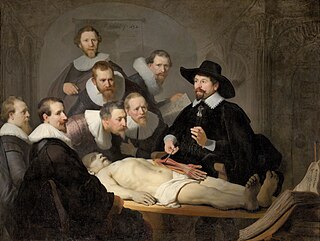
1632 (MDCXXXII) was a leap year starting on Thursday of the Gregorian calendar and a leap year starting on Sunday of the Julian calendar, the 1632nd year of the Common Era (CE) and Anno Domini (AD) designations, the 632nd year of the 2nd millennium, the 32nd year of the 17th century, and the 3rd year of the 1630s decade. As of the start of 1632, the Gregorian calendar was 10 days ahead of the Julian calendar, which remained in localized use until 1923.

Bouillon is a city and municipality of Wallonia located in the province of Luxembourg in the Ardennes, Belgium.

Henri de La Tour d'Auvergne, vicomte de Turenne, commonly known as Turenne, was a French general and one of only six Marshals to have been promoted Marshal General of France. The most illustrious member of the La Tour d'Auvergne family, his military exploits over his five-decade career earned him a reputation as one of the greatest military commanders in history.

François Henri de Montmorency-Bouteville, Duke of Piney-Luxembourg, commonly known as Luxembourg, and nicknamed "The Upholsterer of Notre-Dame", was a French general and Marshal of France. A comrade and successor of the Great Condé, he was one of the most accomplished military commanders of the early modern period and is particularly noted for his exploits in the Franco-Dutch War and War of the Grand Alliance. Not imposing physically, as he was a slight man and hunchbacked, Luxembourg was nonetheless one of France's greatest generals.
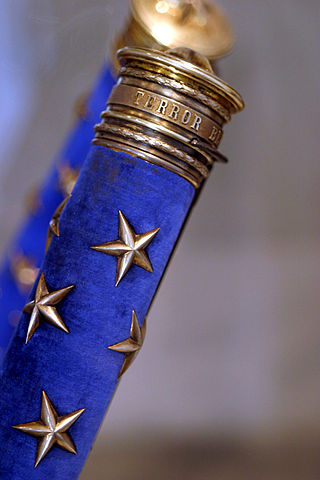
Marshal of France is a French military distinction, rather than a military rank, that is awarded to generals for exceptional achievements. The title has been awarded since 1185, though briefly abolished (1793–1804) and for a period dormant (1870–1916). It was one of the Great Officers of the Crown of France during the Ancien Régime and Bourbon Restoration, and one of the Grand Dignitaries of the Empire during the First French Empire.

Louis François de Boufflers, Duke of Boufflers was a prominent French soldier in the age of Louis XIV of France. He was created count of Cagny and duke of Boufflers and named marshal of France. He was famed for his excellent defensive leadership during the sieges of Namur and Lille, next to his conduct during the Battle of Malplaquet.
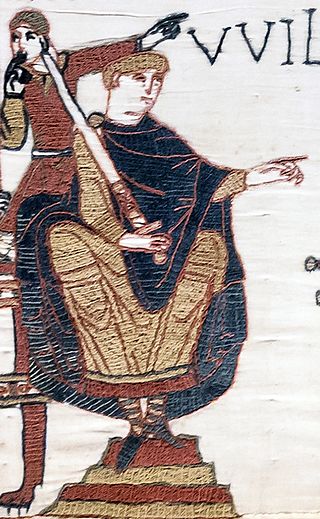
Guillaume is the French equivalent of William, which is of old Germanic origin from wille + helm. It is an Oïl form corresponding to Occitan Guilhem and the Catalan form Guillem.

Henri de La Tour d'Auvergne was a member of the powerful House of La Tour d'Auvergne, the Prince of Sedan and a marshal of France. He was a prominent Huguenot figure.

The House of Rohan is a Breton family of viscounts, later dukes and princes in the French nobility, coming from the locality of Rohan in Brittany. Their line descends from the viscounts of Porhoët and is said to trace back to the legendary Conan Meriadoc. Through the Porhoët family, the Rohans are related to the Dukes of Brittany, with whom the family intermingled again after its inception. During the Middle Ages, it was one of the most powerful families in the Duchy of Brittany. The Rohans developed ties with the French and English royal houses as well, and they played an important role in French and European history.

Jacques de Savoie, duc de Nemours was a French military commander, governor and Prince Étranger. Having inherited his titles at a young age, Nemours fought for king Henri II during the latter Italian Wars, seeing action at the siege of Metz and the stunning victories of Renty and Calais in 1554 and 1558. Already a commander of French infantry, he received promotion to commander of the light cavalry after the capture of Calais in 1558. A year prior he had accompanied François, Duke of Guise on his entry into Italy, as much for the purpose of campaigning as to escape the king's cousin Antoine of Navarre who was threatening to kill him for his extra-marital pursuit of Navarre's cousin.
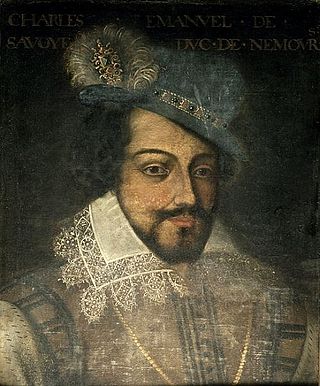
Charles-Emmanuel de Savoie, prince de Genevois and duc de Nemours was a French prince étranger, governor, military commander and rebel during the latter French Wars of Religion. The eldest son of Jacques de Savoie and Anne d'Este, Nemours was a member of a prominent princely family. He entered French political at the age of 18 as a partisan of the second Catholic ligue, rallying cavalry to the rebel army, and assisting in forcing Henri III to capitulate to their demands. In the following years, the king was compelled by the terms of the peace to make war against Protestantism. The former rebel ligueurs hoped the 'cowed' king would afford them advantage, but Henri was keen to dilute the authority of the former rebels. As a result Nemours' position as colonel-general of the light cavalry was diluted with several appointments of royal favourites. During this period, Nemours coveted the governate of the Lyonnais, which had previously been held by his father before 1571. When François de Mandelot, who held the office, died in November 1588, Henri was compelled to recognise Nemours as the new governor due to his political weakness. Frustrated at his continued capitulations to the ligue, on 23 December 1588, Henri assassinated the leader of the ligue the duke of Guise. In the wake of the assassination, Nemours and other ligueur leaders were arrested by the king. Nemours was however quickly able to bribe his guards and secure freedom.

The House of La Tour d'Auvergne was an important French noble dynasty. Its senior branch, extinct in 1501, held two of the last large fiefs acquired by the French crown, the counties of Auvergne and Boulogne, for about half a century. Its cadet branch, extinct in 1802, ruled the duchy of Bouillon in the Southern Netherlands from 1594, and held the dukedoms of Albret and Château-Thierry in the peerage of France since 1660. The name was also borne by Philippe d'Auvergne, an alleged collateral of the original Counts of Auvergne, and was adopted by the famous soldier Théophile Corret de la Tour d'Auvergne, who descended from an illegitimate line of the family.

Louis is the French form of the Old Frankish given name Chlodowig and one of two English forms, the other being Lewis.
A Colonel General was an officer of the French army during the Ancien Régime, the French Revolution, the Napoleonic era and the Bourbon Restoration.

Henry is a masculine given name derived from Old French Henri or Henry, which is derived from the Old Frankish name Heimeric, from Common Germanic “Haimarīks”. In Old High German, the name was conflated with the name Haginrich to form Heinrich.

Anne-Adrien-Pierre de Montmorency, 1st Duke of San Fernando Luis, 3rd Duke of Laval-Montmorency, GE, was a peer of France and of Spain.
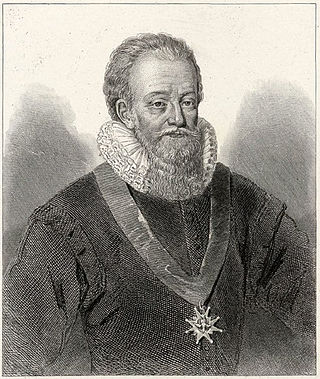
Charles de Montmorency, Duke of Damville was a French aristocrat, military commander, rebel and Admiral during the French Wars of Religion. Damville was the son of Anne de Montmorency, chief favourite of Henri II and Madeleine of Savoy granting him a central place in French politics. As a result in 1562 he was elevated as lieutenant-general of the Île de France, serving under his elder brother François de Montmorency. In 1567, with the establishment of the king's brother Anjou as lieutenant-general of the French army, Méru joined his council to advise him on political matters. Méru participated in the siege of La Rochelle in 1573 under the direction of Anjou. Around this time he developed a proximity to the younger brother of the king Alençon.
The Luxembourg campaigns were two military campaigns by the Dutch Republic and the Duchy of Bouillon against the Spanish Southern Netherlands during the Eighty Years' War in 1593 and 1595. The first was undertaken by a Dutch States Army commanded by Philip of Nassau to the Duchy of Luxembourg in early 1593, with the aim of distracting the Spanish Army of Flanders to a different part of the Habsburg Netherlands, create confusion and block the importation of new pro-Spanish troops to the Low Countries via the Spanish Road. Other goals were dealing economic damage to Spain, and supporting the Protestant claimant to the French throne Henry of Navarre and the Protestant prince of Sedan and duke of Bouillon, Henry de La Tour d'Auvergne.